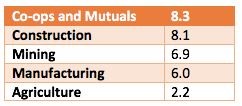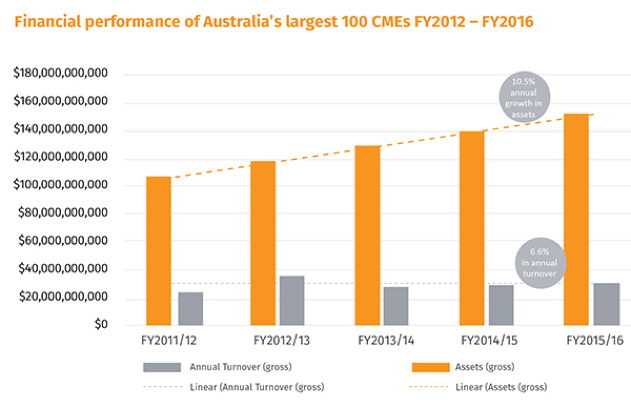10 November 2017
- NME Report 2017 shows the contribution of co-operative and mutual enterprises (CMEs) is 8.3% of Australia’s GDP
- Australia has more than 2,100 active CMEs with more than 29 million members
- $140 billion in total value-add with 76 cents of every dollar reinvested in local communities
- Turnover of Top 100 CMEs grows by 6.6% a year, assets by 10.5% a year
- CMEs directly employ over 146,000 staff
The National Mutual Economy Report 2017 (NME 2017) reveals the enormous contribution co-op and mutual enterprises (CMEs) make to the national economy and the quality of life Australians enjoy.
According to the report, the total value of the goods produced and services provided by CMEs in FY 2015/2016 was the equal to 8.3 per cent of Australia’s Gross Domestic Product (GDP).
To put this in perspective, the contribution made by CMEs to the economy was larger than the construction, mining, manufacturing or agriculture sectors.
FY 2015-2016 Share of GDP (per cent)

Source: Australian Industry Report 2016, Office of The Chief Economist
NME 2017 captures the performance of Australian CMEs, mapping their size, composition and the overall health of the CME sector. The report research partner was the University of Western Australia, and it was sponsored by HCF and published by the Business Council of Co-operatives and Mutuals (BCCM).
In FY 2015/2016, there were at least 2,135 active CMEs generating a total value add of $140 billion and holding assets worth $713.6 billion on behalf of their 29 million members.
Business Council of Co-operatives and Mutuals (BCCM) CEO Melina Morrison said CMEs are a tried and tested model for communities that feel the current economic system is not meeting their needs.
“CMEs are owned by their members, not by investors. This means the needs of members are put first, with a focus on delivering long-term benefits to members rather than short-term profits for investors.”
“Member control also means profits stay within the local community, rather than leaking out or fleeing offshore. The report referenced findings that 76 cents in every dollar spent with a CME stays in the local community, helping contribute to the wealth and quality of life of people who use its products or services. So supporting a CME means supporting your local community.”
Amid new revelations of tax evasion by companies, the strength of the CME sector is vital to securing Australian living standards.
“Strengthening the sector may prove to be the best way for the major parties to protect Australian interests,” Ms Morrison said.
“Despite the contribution of CMEs to the Australian economy, the sector remains relatively unknown and misunderstood. While 85 per cent of Australian adults are members of at least one CME, a recent BCCM poll found that only 12 per cent know they are a member.”
PERFORMANCE OF THE TOP 100 CMEs
The combined annual turnover for the top 100 Australian CMEs (excluding the member owned superannuation funds) for FY2015/16 was approximately $29.9 billion. The turnover of the Top 100 CMEs has grown by an average of 6.6 per cent annually for each of the last five years.
The Top 100 CMEs held combined assets of more than $152.9 billion at the end of FY 2015/16. The value of assets grew by 10.5 per cent during each of the last five years.

SUPPORTING REGIONAL AUSTRALIA
Locally owned and regionally focused agricultural CMEs contribute $8.6bn to the Australian economy every year, providing more than 13,000 farmers and fishers with the support they need to operate locally and sell internationally.
The co-operative support for regional economies goes beyond agriculture, with member-owned banking institutions, energy co-operatives, and many more bringing sustainable development to regional Australia.
Watch the 2017 National Mutual Economy Report video.
For requests: Erin Clare Ph: 0405 258 863


